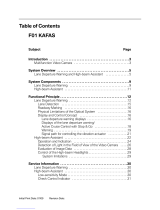Page is loading ...

Technical�training.
Product�information.
BMW�Service
G12�Driver�Assistance�Systems

General�information
Symbols�used
The�following�symbol�is�used�in�this�document�to�facilitate�better�comprehension�or�to�draw�attention
to�very�important�information:
Contains�important�safety�information�and�information�that�needs�to�be�observed�strictly�in�order�to
guarantee�the�smooth�operation�of�the�system.
Information�status�and�national-market�versions
BMW�Group�vehicles�meet�the�requirements�of�the�highest�safety�and�quality�standards.�Changes
in�requirements�for�environmental�protection,�customer�benefits�and�design�render�necessary
continuous�development�of�systems�and�components.�Consequently,�there�may�be�discrepancies
between�the�contents�of�this�document�and�the�vehicles�available�in�the�training�course.
This�document�basically�relates�to�the�European�version�of�left�hand�drive�vehicles.�Some�operating
elements�or�components�are�arranged�differently�in�right-hand�drive�vehicles�than�shown�in�the
graphics�in�this�document.�Further�differences�may�arise�as�the�result�of�the�equipment�specification�in
specific�markets�or�countries.
Additional�sources�of�information
Further�information�on�the�individual�topics�can�be�found�in�the�following:
• Owner's�Handbook
• Integrated�Service�Technical�Application.
Contact:�conceptinfo@bmw.de
©2015�BMW�AG,�Munich
Reprints�of�this�publication�or�its�parts�require�the�written�approval�of�BMW�AG,�Munich.
The�information�contained�in�this�document�forms�an�integral�part�of�the�technical�training�of�the
BMW�Group�and�is�intended�for�the�trainer�and�participants�in�the�seminar.�Refer�to�the�latest�relevant
information�systems�of�the�BMW�Group�for�any�changes/additions�to�the�technical�data.
Information�status:�June�2015
BV-72/Technical�Training

G12�Driver�Assistance�Systems
Contents
1. Introduction.............................................................................................................................................................................................................................................1
2. G12�Bus�Overview...................................................................................................................................................................................................................... 2
3. KAFAS................................................................................................................................................................................................................................................................5
3.1. Detection�range........................................................................................................................................................................................................ 6
3.2. Person�recognition...............................................................................................................................................................................................7
3.3. Road�sign�recognition.....................................................................................................................................................................................8
3.4. Lane�detection........................................................................................................................................................................................................... 8
3.5. Detection�of�the�road�condition......................................................................................................................................................9
3.6. Functional�limitations.......................................................................................................................................................................................9
4. Optional�Equipment�System...............................................................................................................................................................................11
5. Overview�Of�Sensors........................................................................................................................................................................................................ 12
6. Intelligent�Safety.......................................................................................................................................................................................................................14
6.1. Overview�of�the�configuration�menu...................................................................................................................................16
7. Collision�Warning.....................................................................................................................................................................................................................19
7.1. Functional�principle........................................................................................................................................................................................19
7.1.1. Collision�warning�with�city�braking�function.......................................................................... 20
7.1.2. Pedestrian�warning�with�city�braking�function................................................................... 21
7.2. Warning�and�braking�function....................................................................................................................................................... 21
7.2.1. Displays............................................................................................................................................................................................22
7.2.2. Early�warning.......................................................................................................................................................................... 22
7.2.3. Acute�warning....................................................................................................................................................................... 22
7.2.4. Brake�intervention�.........................................................................................................................................................23
7.3. Operation........................................................................................................................................................................................................................ 25
7.4. Limits�of�the�system..................................................................................................................................................................................... 27
8. Lane�Departure�Warning............................................................................................................................................................................................ 28
8.1. Active�steering�intervention.............................................................................................................................................................. 30
8.2. System�wiring�diagram............................................................................................................................................................................. 32
8.3. Deactivation�criteria....................................................................................................................................................................................... 34
8.4. Limits�of�the�system..................................................................................................................................................................................... 34
9. Blind�Spot�Detection.........................................................................................................................................................................................................35
9.1. Active�steering�intervention.............................................................................................................................................................. 37
9.2. System�wiring�diagram............................................................................................................................................................................. 39
9.3. Limits�of�the�system..................................................................................................................................................................................... 40
10. Side�Collision�Warning.................................................................................................................................................................................................. 41

G12�Driver�Assistance�Systems
Contents
10.1. Limits�of�the�system..................................................................................................................................................................................... 44
11. Road�Sign�Recognition................................................................................................................................................................................................. 45
11.1. Operation........................................................................................................................................................................................................................ 46
11.2. Limits�of�the�system..................................................................................................................................................................................... 46
12. Proactive�Active�Driving�Assistant..........................................................................................................................................................49
12.1. Operation........................................................................................................................................................................................................................ 52
12.2. Limits�of�the�system..................................................................................................................................................................................... 53
13. Alertness�Assistant..............................................................................................................................................................................................................54
13.1. Operation........................................................................................................................................................................................................................ 54
13.2. Limits�of�the�system..................................................................................................................................................................................... 56
14. Night�Vision........................................................................................................................................................................................................................................ 57
14.1. System�wiring�diagram............................................................................................................................................................................. 62
14.2. Operation........................................................................................................................................................................................................................ 64
14.3. Limits�of�the�system..................................................................................................................................................................................... 65
15. Cameras..................................................................................................................................................................................................................................................... 66
15.1. Surround�view......................................................................................................................................................................................................... 66
15.1.1. Automatic�camera�angle.......................................................................................................................................67
15.1.2. Side�view....................................................................................................................................................................................... 67
15.1.3. Front�camera........................................................................................................................................................................... 67
15.1.4. Panorama�View.................................................................................................................................................................... 68
15.1.5. Reversing�camera............................................................................................................................................................ 72
15.1.6. Moving�camera�angle................................................................................................................................................ 72
15.2. Overview�of�exterior�camera�operating�menu.......................................................................................................74
15.3. Assistant�function............................................................................................................................................................................................. 77
15.3.1. Car�wash�view....................................................................................................................................................................... 77
15.3.2. Side�protection.................................................................................................................................................................... 77
15.3.3. Door�opening�angle......................................................................................................................................................78
15.4. System�components.................................................................................................................................................................................... 79
15.4.1. Reversing�camera............................................................................................................................................................ 80
15.4.2. TRSVC�control�unit.......................................................................................................................................................81
15.5. System�wiring�diagram............................................................................................................................................................................. 82
16. Park�Distance�Control..................................................................................................................................................................................................... 85
16.1. System�components.................................................................................................................................................................................... 85
16.2. Auto�PDC....................................................................................................................................................................................................................... 86
16.3. Active�Park�Distance�Control..........................................................................................................................................................88
16.4. Side�protection...................................................................................................................................................................................................... 88

G12�Driver�Assistance�Systems
Contents
16.5. Operation........................................................................................................................................................................................................................ 89
16.5.1. Auto�PDC......................................................................................................................................................................................89
16.5.2. Active�Park�Distance�Control........................................................................................................................ 90
16.5.3. Acoustic�signal�output.............................................................................................................................................91
16.6. Deactivation�criteria....................................................................................................................................................................................... 92
16.7. Limits�of�the�system..................................................................................................................................................................................... 93
17. Cross-Traffic�Warning...................................................................................................................................................................................................... 94
17.1. Functional�principle........................................................................................................................................................................................94
17.2. Rear�cross-traffic�warning....................................................................................................................................................................95
17.3. Front�cross-traffic�warning................................................................................................................................................................. 95
17.4. Displays............................................................................................................................................................................................................................. 96
17.5. Operation........................................................................................................................................................................................................................ 97
17.6. Limits�of�the�system..................................................................................................................................................................................... 98
18. Parking�Maneuver�Assistant............................................................................................................................................................................... 99
18.1. System�components.................................................................................................................................................................................... 99
18.2. System�wiring�diagram.........................................................................................................................................................................101
18.3. Control�unit............................................................................................................................................................................................................. 104
18.4. Functional�principle....................................................................................................................................................................................104
18.5. Functional�prerequisites.....................................................................................................................................................................105
18.5.1. Measuring�parking�spaces............................................................................................................................105
18.5.2. Suitable�parking�spaces�parallel�to�the�roadway�(parallel
parking)........................................................................................................................................................................................ 106
18.5.3. Suitable�parking�spaces�perpendicular�to�the�roadway�(bay
parking)........................................................................................................................................................................................ 108
18.5.4. Detection�of�a�universal�parking�space..................................................................................... 111
18.6. Side�protection..................................................................................................................................................................................................112
18.7. Operation.................................................................................................................................................................................................................... 113
18.7.1. Parking�procedure�(parallel�parking).............................................................................................. 114
18.7.2. Parking�procedure�(bay�parking)..........................................................................................................116
18.7.3. Deactivation�criteria................................................................................................................................................. 118
18.8. Limits�of�the�system.................................................................................................................................................................................118
19. Cruise�Control........................................................................................................................................................................................................................... 120
19.1. Introduction.............................................................................................................................................................................................................120
19.2. Cruise�control�with�braking�function...............................................................................................................................120
19.2.1. Control�functions..........................................................................................................................................................120
19.2.2. Activation�of�the�actuators............................................................................................................................121
19.2.3. Operation.................................................................................................................................................................................. 122
19.3. Active�cruise�control�with�Stop&Go�function....................................................................................................123

G12�Driver�Assistance�Systems
Contents
19.3.1. Control�functions..........................................................................................................................................................126
19.3.2. Operation.................................................................................................................................................................................. 127
19.3.3. System�wiring�diagram....................................................................................................................................... 132
20. Speed�Limit�Warning.................................................................................................................................................................................................... 134
20.1. Operation.................................................................................................................................................................................................................... 134
21. Lateral�Guidance�Assistants...........................................................................................................................................................................135
22. Lane�&�Traffic�Jam�Assistant........................................................................................................................................................................136
22.1. Functional�principle....................................................................................................................................................................................136
22.1.1. Hands-off-Detection............................................................................................................................................... 138
22.1.2. Functional�prerequisites................................................................................................................................... 140
22.1.3. Lane�change........................................................................................................................................................................141
22.1.4. Function�logic.................................................................................................................................................................... 141
22.1.5. Steering�interventions..........................................................................................................................................142
22.1.6. Operation.................................................................................................................................................................................. 143
22.1.7. System�wiring�diagram....................................................................................................................................... 145
22.1.8. Deactivation�criteria................................................................................................................................................. 147
22.1.9. Limits�of�the�system............................................................................................................................................... 147
23. Active�Lane�Keeping�Assistant................................................................................................................................................................. 148
23.1. Side�collision�warning............................................................................................................................................................................ 148
23.1.1. Reduced�side�collision�warning............................................................................................................ 148
23.2. Lane�departure�warning......................................................................................................................................................................149
23.3. Blind�spot�detection................................................................................................................................................................................. 150

G12�Driver�Assistance�Systems
1.�Introduction
1
The�range�of�existing�assistance�systems�has�been�expanded�in�the�G12�to�include�new�innovative
systems.�The�interplay�between�the�varied�and�intelligent�assistance�systems�supports�the�driver�in
every�respect;�from�making�driving�more�comfortable�to�providing�the�reassuring�feeling�of�safety
on�all�roads.
The�assistance�systems�help�to�make�the�driver's�life�easier�by:
• providing�the�driver�with�information
• prompting�the�driver�with�suggestions
• automatically�intervening�in�the�driving�process
This�information�bulletin�contains�an�overview�of�all�the�assistance�systems�used�in�the�G12:
• Camera-based�collision�warning
• Collision�warning�with�city�braking�function
• Pedestrian�warning�with�city�braking�function
• Road�sign�recognition
• Proactive�Active�Driving�Assistant
• Lane�departure�warning
• Blind�spot�detection
• Side�collision�warning
• Alertness�assistant
• Night�vision
• Camera�systems
• cross-traffic�warning
• Park�Distance�Control
• Parking�Maneuver�Assistant
• Speed�control
• Speed�limit�warning
• Steering�and�lane�control�assistant�including�traffic�jam�assistant
• Active�Lane�keeping�assistant�with�active�side�collision�protection
Identifying�road�users�driving�ahead�as�well�as�detecting�objects�and�lane�edges�are�among�the�most
important�prerequisites�for�the�assistance�systems.�This�applies�not�only�for�the�far�range�but�also�the
close�range.
The�optional�functions�available�for�the�G12�are�implemented�either�as�camera-based�systems�with�a
shared�camera�and�integrated�control�unit,�or�as�sensor�systems�such�as�ultrasonic�or�radar�sensors.
Evaluation�signals�provided�by�various�control�units�(for�example,�from�the�Advanced�Crash�Safety
Module�(ACSM))�are�also�taken�into�consideration.
For�more�information�on�the�operating�concept�of�the�assistance�systems,�please�refer�to�the�Owner's
Handbook.

G12�Driver�Assistance�Systems
2.�G12�Bus�Overview
2
G12�bus�overview

G12�Driver�Assistance�Systems
2.�G12�Bus�Overview
3
Index Explanation
ACC Active�cruise�control
ACSM Advanced�Crash�Safety�Module
AMPT Top�Hi-Fi�amplifier
ASD Active�Sound�Design
BDC Body�Domain�Controller
CON Controller
DME Digital�Motor�Electronics
DME2 Digital�Engine�Electronics�2
DSC Dynamic�Stability�Control
EARSH Electric�active�roll�stabilization�rear
EARSV Electric�active�roll�stabilization�front
EGS Electronic�transmission�control
EPS Electromechanical�Power�Steering
FLA High-beam�assistant
FLER Frontal�Light�Electronics�Right
FLEL Frontal�Light�Electronics�Left
FZD Roof�function�centre
GWS Gear�selector
HEADUNIT Head�unit
HKFM Tailgate�function�module
HSR Rear�axle�slip�angle�control
IHKA Integrated�automatic�heating�/�air�conditioning
KAFAS Camera-based�driver�support�systems
KOMBI Instrument�panel
LEM Light�effect�manager
NFC Near�Field�Communication
NVE Night�Vision�Electronics
PCU Power�Control�Unit
PMA Parking�Maneuver�Assistant
RFK Reversing�camera
RSE Rear�Seat�Entertainment
RSL Radar�sensor,�left�(avoidance�assistant)
RSR Radar�sensor,�right�(avoidance�assistant)
SAS Optional�equipment�system
SMBF Seat�module,�passenger

G12�Driver�Assistance�Systems
2.�G12�Bus�Overview
4
Index Explanation
SMBFH Seat�module,�passenger,�rear
SMFA Seat�module,�driver
SMFAH Seat�module,�driver,�rear
SPNMHL Seat�pneumatics�module�back�left
SPNMHR Seat�pneumatics�module�back�right
SPNMVL Seat�pneumatics�module�front�left
SPNMVR Seat�pneumatics�module�front�right
SWW Blind�spot�detection�(primary)
SWW2 Blind�spot�detection�(secondary)
TCB Telematic�Communication�Box
TRSVC Top�rear�side�view�camera
VDP Vertical�dynamic�platform
VTG Transfer�box
WCA Wireless�charging�oddments�tray
ZGM Central�gateway�module
1 Start-up�node�control�units�for�starting�and�synchronizing
the�FlexRay�bus�system
2 Control�units�with�wake-up�authorization
3 Control�units�also�connected�at�terminal�15WUP

G12�Driver�Assistance�Systems
3.�KAFAS
5
As�the�requirements�placed�on�the�KAFAS�camera�have�increased�in�the�G12,�the�existing
monochrome�camera�has�been�replaced�by�a�stereo�camera.
KAFAS�stereo�camera
The�KAFAS�stereo�camera�is�composed�of�two�high-resolution�CMOS�monochrome�cameras,
which�are�installed�in�a�housing�with�approximately�20�cm�between�them.�The�KAFAS�stereo�camera
housing�now�also�serves�as�an�equipment�holder�for�the�KAFAS�control�unit,�which�has�more�powerful
processors.
KAFAS�stereo�camera
CMOS�cameras�are�characterized�by�their�low�power�consumption,�compact�size�and�very�high
frame�rate.
CMOS�=�Complementary�Metal�Oxide�Semiconductor
The�KAFAS�stereo�camera�is�calibrated�within�a�distance�of�approximately�2�km�during�driving.
The�KAFAS�stereo�camera�is�the�key�element�of�the�following�systems:

G12�Driver�Assistance�Systems
3.�KAFAS
6
• Tailgate�warning
• Collision�warning�with�city�braking�function
• Pedestrian�warning�with�city�braking�function
• Lane�departure�warning
• Road�sign�recognition.
The�KAFAS�stereo�camera�plays�a�supporting�role�in�the�following�systems:
• Active�Cruise�Control�with�Stop&Go�(ACC)
• Steering�and�lane�control�assistant�including�traffic�jam�assistant
• Active�lane�keeping�assistant�with�active�side�collision�protection
3.1.�Detection�range
Due�to�differences�in�perspective�between�the�left�and�right�optical�path�of�the�camera,�the�stereo
camera�is�able�to�measure�the�distance�to�an�object�and�now�also�its�height�above�road�level.
While�the�monochrome�camera�merely�estimates�distances,�the�stereo�camera�can�determine�the
distance�to�an�object�fairly�accurately�–�to�within�approximately�20�to�30�cm�–�from�approximately
40�m�away.
KAFAS�stereo�camera�detection�range

G12�Driver�Assistance�Systems
3.�KAFAS
7
In�principle,�the�evaluation�electronics�in�the�KAFAS�stereo�camera�use�the�same�effect�as�is�used�in�a
human�to�create�spatial�vision.�This�is�known�as�the�parallax�shift�between�two�images.
The�KAFAS�stereo�camera�not�only�enables�the�position�of�an�object�to�be�determined,�but�also�its
movement�and�direction�of�movement.�For�every�pixel�of�a�detected�object,�the�direction�of�movement
on�the�horizontal,�vertical�and�longitudinal�axis�can�be�determined.
The�KAFAS�stereo�camera�has�a�detection�range�of�up�to�approximately�40m�ahead�of�the�vehicle�and
up�to�approximately�5m�in�front�of�the�vehicle�on�the�right�and�left.�The�overall�detection�range�of�the
KAFAS�stereo�camera�is�approximately�500�m.
3.2.�Person�recognition
The�KAFAS�stereo�camera�captures�the�scene�in�front�of�the�vehicle�and�detects�entire�rear�views�of
moving�and�stationary�vehicles�in�the�field�of�view�using�image�processing.�The�KAFAS�stereo�camera
also�ensures�that�driving�lane�information,�vehicle�positions�and�movements�are�determined�at�the
same�time.
With�the�aid�of�the�image�data�from�the�KAFAS�stereo�camera,�objects�can�be�clearly�identified�as
vehicles�and�their�transverse�movements�as�lane�changes.�The�KAFAS�stereo�camera�also�detects
people�and�cyclists.
Example�of�pedestrian�recognition�by�the�KAFAS�stereo�camera:�pedestrian�approaching�from�the�side�steps�into�the�road�and�is�partially�hidden
The�two�separate�optical�paths�are�also�beneficial�in�challenging�conditions,�for�example�difficult
lighting�conditions,�where�there�is�low�contrast�between�the�image�and�background�or�when�several
objects�are�closely�lined�up�one�after�the�other.
Thanks�to�the�redundant�image�detection�of�the�stereo�camera,�it�is�now�possible�to�reliably�detect
obstacles�and�determine�their�size�from�a�single�image.

G12�Driver�Assistance�Systems
3.�KAFAS
8
3.3.�Road�sign�recognition
The�KAFAS�stereo�camera�is�also�responsible�for�detecting�top�speed�limitation�road�signs.
The�detection�of�no�overtaking/overtaking�permitted�signs�or�markings�is�also�implemented�in
the�G12.
3.4.�Lane�detection
The�KAFAS�stereo�camera�installed�in�the�mirror�base�of�the�interior�mirror�on�the�windshield�monitors
the�area�in�front�of�the�vehicle.
KAFAS�stereo�camera
Index Explanation
1 KAFAS�stereo�camera
2 Rain‐light‐solar-condensation�sensor
3 Photosensor�for�electrochromic�interior�mirror
The�KAFAS�stereo�camera�records�the�roadway�up�to�approximately�40m�ahead�of�the�vehicle�and
up�to�approximately�5m�to�the�right�and�left�of�the�vehicle.�The�image�data�is�then�evaluated�by�the
KAFAS�control�unit�integrated�in�the�KAFAS�stereo�camera.�Using�image�processing,�the�control�unit
searches�the�images�recorded�by�the�KAFAS�stereo�camera�for�lane�and�road�markings.
The�appearance�of�the�road�markings�can�vary�considerably�in�the�image�depending�on�the�country,
type�of�road�or�the�current�ambient�conditions.�The�system�can�detect�a�wide�range�of�road�markings
and�types�of�markings.�For�a�lane�marking�to�be�evaluated,�the�KAFAS�stereo�camera�and�the�KAFAS
control�unit�must�first�be�able�to�clearly�identify�it.�A�lane�must�also�have�an�average�width�greater�than
2.5m�for�it�to�be�evaluated.

G12�Driver�Assistance�Systems
3.�KAFAS
9
3.5.�Detection�of�the�road�condition
The�KAFAS�stereo�camera�in�the�G12�also�detects�the�road�condition.
In�vehicles�with�the�Executive�Drive�Pro�optional�equipment�(OE�2VS),the�data�collected�is�used
to�adapt�the�chassis�and�suspension�setting�to�the�road�condition�by�changing�various�setting
parameters�in�the�Dynamic�Drive�(ARS)�and�Electronic�Damper�Control�(EDC)�and�tailoring�the
interaction�with�the�two-axle�air�suspension.
Detection�of�road�bumps�with�the�help�of�the�stereo�camera
Objects�can�now�be�dealt�with�actively�instead�of�reactively,�and�therefore�more�easily,�at�speeds�of
approximately�15�to�100�km/h.
The�structure�of�the�vehicle�moves�less�vertically,�as�the�vehicle�drives�in�harmony�with�the�road.
Bumps�are�less�noticeable�for�the�driver.
3.6.�Functional�limitations
The�function�of�the�KAFAS�stereo�camera�and�thus�the�function�of�the�corresponding�assistance
systems�may�be�impaired�due�to�the�physical�limits�of�the�optical�systems,�for�example�in�the
following�situations:
• Heavy�fog,�rain,�spray�or�snow
• Strong�light�in�the�camera�lens
• If�the�field�of�view�of�the�KAFAS�stereo�camera�or�the�windscreen�is�dirty
• On�tight�bends
• If�boundary�lines�are�missing,�worn,�poorly�visible,�converging�or�diverging,�or�not
clearly�recognizable,�as�may�be�the�case�when�roadworks�are�being�carried�out
• If�boundary�lines�are�covered�by�snow,�ice,�dirt�or�water
• If�boundary�lines�are�covered�by�objects

G12�Driver�Assistance�Systems
3.�KAFAS
10
• If�driving�at�close�proximity�to�a�vehicle�driving�ahead
• If�the�windscreen�in�front�of�the�interior�mirror�is�misted�over,�soiled�or�covered�by�stickers,�e.g.
tax�discs,�etc.
• Up�to�10�seconds�after�driving�readiness�is�activated�via�the�start/stop�button
• During�the�calibration�process�for�the�KAFAS�stereo�camera�immediately�after�vehicle�delivery
or�a�camera�change
Example�of�limits�of�the�KAFAS�stereo�camera
Due�to�functional�limitations�and�system�restrictions�it�may�transpire�that�warnings�and�orders�are�not
issued,�are�issued�too�late�or�are�unwarranted.�Therefore,�be�attentive�in�order�to�be�able�to�actively
intervene�at�any�time.�Otherwise,�there�is�a�risk�of�an�accident.

G12�Driver�Assistance�Systems
4.�Optional�Equipment�System
11
The�familiar�optional�equipment�system�(SAS)�control�unit�is�also�used�in�the�G12�and�provides�a�range
of�driver�assistance�functions.
Possible�functions:
• Tailgate�warning
• Collision�warning�with�city�braking�function
• Pedestrian�warning�with�city�braking�function
• Dynamic�Brake�Control
• Distance�information
• Dynamic�Cruise�Control
• Active�speed�control�with�Stop&Go�function
• Lane�&�traffic�jam�assistant
• Speed�limit
• Blind�spot�detection
• Lane�departure�warning
• Cross-traffic�warning
• Parking�Maneuver�Assistant
• Proactive�Active�Driving�Assistant
G12�optional�equipment�system�(SAS)�control�unit

G12�Driver�Assistance�Systems
5.�Overview�Of�Sensors
12
The�graphic�below�provides�an�overview�of�the�main�sensors�used�in�the�G12�for�the�assistance
systems�and�shows�their�installation�locations.
G12�overview�of�sensors

G12�Driver�Assistance�Systems
5.�Overview�Of�Sensors
13
Index Explanation
1 Control�unit�for�radar�sensor,�right�(RSR)
2 KAFAS�stereo�camera
3 Blind�spot�detection,�right�(primary)
4 Blind�spot�detection,�left�(secondary)
5 Control�unit�for�radar�sensor,�left�(RSL)
6 Active�Cruise�Control�(ACC)�(FRR)
7 Night�Vision�camera

G12�Driver�Assistance�Systems
6.�Intelligent�Safety
14
Due�to�the�ever�increasing�amount�of�traffic�on�our�roads,�assistance�systems�in�vehicles�continue�to
gain�in�importance.�They�assist�the�driver�on�highways,�single-lane�roads�and�in�urban�environments.
Urban�traffic�is�just�one�area�that�presents�an�ever�increasing�number�of�challenges.�Car�drivers�must
be�constantly�aware�of�cyclists�and�pedestrians.�Systems�such�as�the�pedestrian�warning�with�city
brake�activation�are�helpful�in�this�respect.�Night�Vision�can�assist�the�driver�when�driving�on�single-
lane�roads�with�adjacent�woodland�(deer�crossings,�etc.).�The�lane�departure�and�Blind�spot�detection
as�well�as�the�side�collision�warning�provide�even�more�safety�in�traffic.�Accidents�can�be�avoided
through�automatic�brake�interventions,�active�steering�interventions�or�a�combination�of�both.
Depending�on�the�vehicle�equipment,�Intelligent�Safety�consists�of�one�or�several�systems,�which�can
help�to�avoid�a�potential�collision.�The�following�systems�are�offered�in�the�G12:
• Tailgate�warning�with�braking�function
• Pedestrian�warning�with�city�braking�function
• Night�Vision�with�person�and�animal�recognition
• Lane�departure�warning
• Blind�spot�detection
• Side�collision�warning
The�Intelligent�Safety�button�enables�the�assistance�systems�to�be�operated�centrally.�This�means�the
systems�can�be�switched�on�or�off�using�a�button�and�the�submenu�can�be�called�up�to�personalize�the
settings.
G12�Intelligent�Safety�button
Index Explanation
1 Intelligent�Safety�button
/
